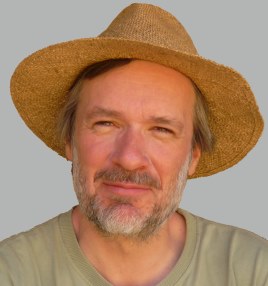Abdelkader di Carlo I, Braconnot P, Marti O, Elliot M (2020) Is the increase in the variability of El Niño over the last 6000 years linked to the mean state changes of the tropical Pacific Ocean?
Alkama R, Kageyama M, Ramstein G, et al (2008) Impact of a realistic river routing in coupled ocean-atmosphere simulations of the Last Glacial Maximum climate. Clim Dyn 30:855–869
Arsouze T, Dutay J-C, Kageyama M, et al (2008) A modeling sensitivity study of the influence of the Atlantic meridional overturning circulation on neodymium isotopic composition at the Last Glacial Maximum. Clim Past 4:191–203
Aumont O, Orr JC, Jamous D, et al (1998) A degradation approach to accelerate simulations to steady-state in a 3-D tracer transport model of the global ocean. Clim Dyn 14:101–116
Barthelet P, Bony S, Braconnot P, et al (1998) Global coupled simulations of climate change due to increased atmospheric CO2 concentration. Comptes Rendus De l’Academie Des Sciences Serie Ii Fascicule a-Sciences De La Terre Et Des Planetes 326:677–684
Braconnot P, Albani S, Balkanski Y, et al (2020) Impact of dust in PMIP4-CMIP6 Mid-Holocene simulations with the IPSL model, conference PMIP4
Braconnot P, Crétat J, Marti O, et al (2019a) Impact of Multiscale Variability on Last 6,000 Years Indian and West African Monsoon Rain. Geophys Res Lett 46:14021–14029.
https://doi.org/10.1029/2019GL084797Braconnot P, Crétat J, Marti O (2019b) A long term perspective on Monsoon variability and extreme dry or wet years. In: EGU General Assembly Conference Abstracts. Wien
Braconnot P, Hourdin F, Bony S, et al (2007a) Impact of different convective cloud schemes on the simulation of the tropical seasonal cycle in a coupled ocean-atmosphere model. Clim Dyn 29:501–520.
https://doi.org/10.1007/s00382-007-0244-yBraconnot P, Joussaume S, de Noblet N, Marti O (1999a) La modélisation du climat d’il y a 6000 ans. Images de la Physique 92–98
Braconnot P, Joussaume S, Marti O, de Noblet N (2000a) Impact of ocean and vegetation feedback on 6ka monsoon changes. In: Braconnot P (ed). WCRP, pp 211–216
Braconnot P, Joussaume S, Marti O, de Noblet N (1999b) Synergistic feedbacks from ocean and vegetation on the African monsoon response to mid-Holocene insolation. Geophys Res Lett 26:2481–2484
Braconnot P, Marti O (2003a) Modeling the climate. Biofutur 28-+
Braconnot P, Marti O (2003b) Impact of precession on monsoon characteristics from coupled ocean atmosphere experiments: changes in Indian monsoon and Indian ocean climatology. Mar Geol 201:23–34
Braconnot P, Marti O (1996) Sensibilité du modèle couplé basse résolution de l’IPSL à des paramétrisations simples de la glace de mer
Braconnot P, Marti O, Crétat J, et al (2019c) Transient simulations of the last 6000 years with the IPSL model. In: PMIP Workshop group P2FVAR
Braconnot P, Marti O, Joussaume S (1996) Water vapour and cloud feedbacks during the adjustment of the IPSL (LMD/OPA) model
Braconnot P, Marti O, Joussaume S, Leclainche Y (2000b) Ocean feedback in response to 6 kyr BP insolation. J Climate 13:1537–1553
Braconnot P, Marzin C, Gregoire LJ, et al (2008) Monsoon response to changes in Earth’s orbital parameters: comparisons between simulations of the Eemian and of the Holocene. Clim Past 4:281–294
Braconnot P, Otto-Bliesner B, Harrison S, et al (2007b) Results of PMIP2 coupled simulations of the Mid-Holocene and Last Glacial Maximum – Part 2: feedbacks with emphasis on the location of the ITCZ and mid- and high latitudes heat budget. Clim Past 3:279–296
Braconnot P, Otto-Bliesner B, Harrison S, et al (2007c) Results of PMIP2 coupled simulations of the Mid-Holocene and Last Glacial Maximum – Part 1: experiments and large-scale features. Clim Past 3:261–277
Braconnot P, Zhu D, Marti O, Servonnat J (2019d) Strengths and challenges for transient Mid- to Late Holocene simulations with dynamical vegetation. Clim Past 15:997–1024.
https://doi.org/10.5194/cp-15-997-2019Carré M, Braconnot P, Elliot M, et al (2021) High-resolution marine data and transient simulations support orbital forcing of ENSO amplitude since the mid-Holocene. Quaternary Science Reviews 268:107125.
https://doi.org/10.1016/j.quascirev.2021.107125Crétat J, Braconnot P, Marti O (2019) Multi-scale changes in the Indian Summer Monsoon rainfall: insights from mid- to late Holocene transient simulations. In: EGU General Assembly Conference Abstracts. Wien
Crétat J, Braconnot P, Marti O, Terray P (2018) ENSO and the Indian Summer Monsoon (ISM): Mid-Holocene to present relationship in transient global simulations. In: International ENSO CLIVAR conference. Guayaquil
Gladstone RM, Ross I, Valdes PJ, et al (2005) Mid-Holocene NAO: A PMIP2 model intercomparison. Geophys Res Lett 32:
Govin A, Braconnot P, Capron E, et al (2012) Persistent influence of ice sheet melting on high northern latitude climate during the early Last Interglacial. Clim Past 8:483–507
Hourdin F, Foujols M-A, Codron F, et al (2012) Impact of the LMDZ atmospheric grid configuration on the climate and sensitivity of the IPSL-CM5A coupled model. Clim Dyn.
https://doi.org/10.1007/s00382-012-1411-3Kageyama M, Albani S, Braconnot P, et al (2017) The PMIP4 contribution to CMIP6 – Part 4: Scientific objectives and experimental design of the PMIP4-CMIP6 Last Glacial Maximum experiments and PMIP4 sensitivity experiments. Geosci Model Dev 10:4035–4055.
https://doi.org/10.5194/gmd-10-4035-2017Kageyama M, Braconnot P, Bopp L, et al (2012a) Mid-Holocene and last glacial maximum climate simulations with the IPSL model: part II: model-data comparisons. Clim Dyn 40:2469–2495.
https://doi.org/10.1007/s00382-012-1499-5Kageyama M, Braconnot P, Bopp L, et al (2012b) Mid-Holocene and Last Glacial Maximum climate simulations with the IPSL model-part I: comparing IPSL_CM5A to IPSL_CM4. Clim Dyn 40:2447–2468.
https://doi.org/10.1007/s00382-012-1488-8Kageyama M, Mignot J, Swingedouw D, et al (2009) Glacial climate sensitivity to different states of the Atlantic Meridional Overturning Circulation: results from the IPSL model. Clim Past 5:551–570
Khodri M, Leclainche Y, Ramstein G, et al (2001) Simulating the amplification of orbital forcing by ocean feedbacks in the last glaciation. Nature 410:570–574
Le Clainche Y, Braconnot P, Marti O, Joussaume S (1998) Apport du modèle thermodynamique de glace de mer dans les simulations couplées basse résolution de l’IPSL. In: France M (ed)
Leclainche Y, Braconnot P, Marti O, et al (2001) The role of sea ice thermodynamics in the Northern Hemisphere climate as simulated by a global coupled ocean-atmosphere model. IPSL
Luan Y, Braconnot P, Yu Y, et al (2012) Early and mid-Holocene climate in the tropical Pacific: seasonal cycle and interannual variability induced by insolation changes. Clim Past 8:1093–1108
Madec G, Marti O (1990) Traitement des îles dans le modèle de circulation générale du LODYC. LODYC
Marti O (2021) Quantifying the errors of the coupling schemes at the ocean-atmosphere interface in Earth system models, using a mathematically consistent Schwarz iterative method
Marti O (2010) La puissance des super-calculateurs au service de la modélisation du climat. Le calcul intensif?: technologie clé pour le futur – Cahier ANR 3:148
Marti O (1993a) Toward a world ocean model for climate studies. In: Pave A (ed). Society for Computer Simulation, pp 3–7
Marti O (1992) Etude de l’océan mondial: modélisation de la dynamique et du transport de traceurs anthropogéniques. Thèse de l’Université Paris VI, Paris VI
Marti O, Bassinot F, Braconnot P, et al (2020a) Transient Holocene simulations compared to deep sea cores in the Indian ocean
Marti O, Braconnot P, Joussaume S (1998) African and Asian monsoon changes at 6000 BP inferred from a full coupled ocean-atmosphere model. In: EGS (ed)
Marti O, Braconnot P, Leclainche Y (1997) Reorganization of oceanic and atmospheric heat transport in an ocean-atmopshere coupled model
Marti O, Dutay J-C, Mémery L, Delecluse P (1991) Study of the world ocean circulation. Three-dimensional modelling and validation by the simulation of transient tracer transport. p 192
Marti O, Lemarié F, Blayo E, Valcke S (2021a) A Schwarz iterative method to evaluate ocean-atmosphere coupling schemes. In: IX International Conference on Coupled Problems in Science and Engineering – COUPLED 2021. on-line
Marti O, Madec G, Delecluse P (1992) Comment on “net diffusivity in ocean general circulation models with nonuniform grid.” J Geophys Res 97:12,763-12,766
Marti O, Nguyen S, Braconnot P, et al (2021b) Diagnosing the ocean-atmosphere coupling schemes by using a mathematically consistent Schwarz iterative method. In: Research activities in Earth system modelling. Working Group on Numerical Experimentation., E. Astakhova. WMO, Geneva, pp 9–03
Marti O, Nguyen S, Braconnot P, et al (2021c) A Schwarz iterative method to evaluate ocean–atmosphere coupling schemes: implementation and diagnostics in IPSL-CM6-SW-VLR. Geosci Model Dev 14:2959–2975.
https://doi.org/10.5194/gmd-14-2959-2021Marti O, Nguyen S, Braconnot P, et al (2020b) Iterative Schwarz method to couple ocean and atmosphere in a Global Climate Model. In: EGU General Assembly. on-line
Marti O, Nguyen S, Braconnot P, et al (2020c) A Schwarz iterative method to evaluate ocean- atmosphere coupling schemes. Implementation and diagnostics in IPSL-CM6-SW-VLR. GMD-2020-307
Masson-Delmotte V, Kageyama M, Braconnot P, et al (2006) Past and future polar amplification of climate change: climate model intercomparisons and ice-core constraints. Clim Dyn 1
Orr JC, Mémery L, Marti O, Dutay J-C (1994) Transient tracer vs. anthropogenic CO2 uptake in a general circulation model of the world ocean
Otto-Bliesner BL, Schneider RR, Brady EC, et al (2009) A comparison of PMIP2 model simulations and the MARGO proxy reconstruction for tropical sea surface temperatures at last glacial maximum. Clim Dyn 32:799–815
Séférian R, Gehlen M, Bopp L, et al (2016) Inconsistent strategies to spin up models in CMIP5: implications for ocean biogeochemical model performance assessment. Geosci Model Dev 9:1827–1851.
https://doi.org/10.5194/gmd-9-1827-2016Sepulchre P, Caubel A, Ladant J-B, et al (2020) IPSL-CM5A2 – an Earth system model designed for multi-millennial climate simulations. Geophys Res Lett 13:3011–3053.
https://doi.org/10.5194/gmd-13-3011-2020Silvestri G, Berman AL, Braconnot P, Marti O (2022) Long-term trends in the Southern Annular Mode from transient Mid- to Late Holocene simulation with the IPSL-CM5A2 climate model. Clim Dyn.
https://doi.org/10.1007/s00382-022-06160-0Swingedouw D, Braconnot P, Delecluse P, et al (2007) Quantifying the AMOC feedbacks during a 2xCO(2) stabilization experiment with land-ice melting. Clim Dyn 29:521–534
Swingedouw D, Braconnot P, Delecluse P, et al (2006a) The impact of global freshwater forcing on the thermohaline circulation: adjustment of North Atlantic convection sites in a CGCM. Clim Dyn 28:291–305
Swingedouw D, Braconnot P, Marti O (2006b) Sensitivity of the Atlantic Meridional Overturning Circulation to the melting from northern glaciers in climate change experiments. Geophys Res Lett 33:.
https://doi.org/10.1029/2006GL025765Torres O, Braconnot P, Gainusa-Bogdan A, et al (2016) Influence and impact of the parametrization of the turbulent air-sea fluxes on atmospheric moisture and convection in the tropics. In: EGU General Assembly Conference Abstracts. pp EPSC2016-8517
Torres O, Braconnot P, Marti O (2018) Impact of gustiness in turbulent heat flux parameterization on the air-sea coupling and ocean feedbacks in climate simulation
Torres O, Braconnot P, Marti O (2017) Comparing the effect of low wind spead parameterization on heat fluxes in atmosphere only and coupled ocean-atmosphere simulations
Torres O, Braconnot P, Marti O, Gential L (2019) Impact of air-sea drag coefficient for latent heat flux on large scale climate in coupled and atmosphere stand-alone simulations. Clim Dyn 52:2125–2144.
https://doi.org/10.1007/s00382-018-4236-xYseki M, Turcq B, Caquineau S, et al (2020) Centennial to millennial variability of winds and precipitation in the Eastern South Pacific during the Holocene: A new data-model comparison
Zhao Y, Braconnot P, Harrison SP, et al (2007) Simulated changes in the relationship between tropical ocean temperatures and the western African monsoon during the mid-Holocene. Clim Dyn 28:533–551
Zhao Y, Braconnot P, Marti O, et al (2005) A multi-model analysis of the role of the ocean on the African and Indian monsoon during the mid-Holocene. Clim Dyn 25:777–800

